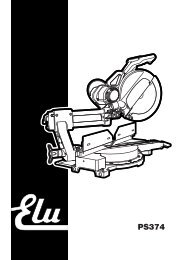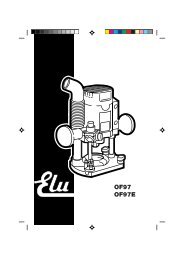Create successful ePaper yourself
Turn your PDF publications into a flip-book with our unique Google optimized e-Paper software.
ENGLISHAssembly for mitre saw modeMounting the under-table guard (fig. D)The under-table guard (48) is fitted to the top of the saw bench table.• Place the two hooks on the left of the guard into the oblong slots (49)on the left of the blade slot (50).• Place the guard flat on the table and press it in the locking grommet (51).• To remove, loosen the grommet with a screwdriver (52) and proceed inreverse order.Turning the sawhead and table over (fig. A2, E1 & E2)• Withhold the saw table with one hand and push the table release lever (19)to the left (fig. E1).• Push the table downwards at the front and swing it over completelyuntil the motor assembly is uppermost and the indentation engages inthe retaining teeth of the table locking device (26).• The head assembly is held down by a clamp strap at the front and aheight adjuster (22) at the rear (fig. A2).• Remove the strap.• Rotate the circular wheel (53) counterclockwise whilst holding downthe head until the “U”-shaped bracket (54) can be disengaged from itsseating (fig. E2).• Swing the height adjuster up and push the rod (55) into the clip (56).• Holding the head firmly, allow the spring pressure to take the headupwards into its rest position.Mounting the saw blade (fig. A1, F1 - F3)• The teeth of a new blade are very sharp and can be dangerous.• Always change blades with the machine in mitre saw mode.• The maximum diameter blade that can be fitted is 250 mm.The minimum diameter is 244 mm.• Loosen the riving knife clamping knob (27) and allow the riving knife (30)to swing downwards (fig. F1).• Place the 6 mm Allen key into the end of the blade bolt (13) and thetwo pins of the pin spanner (57) into the holes on the outer flange (14).• The blade bolt has a left-handed thread, therefore holding the spannerfirmly, turn the Allen key clockwise to loosen.• Remove the blade bolt (13) and remove the outer flange (14).• If the blade bolt is too tight, turn the handle of the pin spanner (57) intothe guard and lock it there using a screwdriver (58) (fig. F2). This allowsto exert extra pressure on the Allen key.• The blade (59) has a 30 mm bore, and is located on a step flange (60)on the inner flange (61) (fig. F1).• Press the guard retraction lever (12) and move the head down slightlyto release the lower guard (15) (fig. A1).• Rotate the lower blade guard all the way up and hold it there.• Make sure the inner flange and both faces of the blade are clean andfree of dust.• Place the blade onto the step flange (60) on the inner flange (61),ensuring that the teeth are pointing downwards (fig. F1).• Carefully ease the blade into position and release the lower blade guard.• Also ensure that the two projections (62) on the outer collar are seatedproperly through the inner collar and onto the flats on the spindle.• Tighten the blade bolt securely.• Rotate the blade by hand to check that it rotates freely. If it fouls thelower rear blade guard (9), retighten the crosshead screws (63) (fig. F3).• Reposition the riving knife (30) in the upper rest position and tighten theclamping knob (27) (fig. F1).Adjusting the mitre saw mode depth limiter (fig. G)The handle (64) is connected to a depth stop rod (21) which has aneccentrically positioned adjustable bolt (65) with locknut (66). When the depthlimiter is engaged, the saw head cannot be pulled down completely (fig. G).- Handle to the left = engaged, for use in mitre saw mode(all angles except 0-45° mitre cross cut)- Handle to the right = disengaged, for use in saw bench mode• If the depth limiter needs adjustment, loosen the locknut (66)and screw the bolt (65) in or out as required.Incorrect use of the depth limiter may cause damage to themachine.Adjusting the mitre angle in mitre saw mode (fig. A1, A2 & H)The straight cross-cut and 45° mitre positions are pre-set.• Lift the rotating table clamp (17), pull up the rotating table locationplunger (8) and rotate it counterclockwise a quarter of a turn (fig. A1).• Grip the control handle (20) (fig. A1), compress the guard retractionlever (12) and lower the saw about halfway (fig. A2).• Turn the sawhead with its rotating table to the required position.• Push down the rotating table clamp (17). The rotating table locationplunger (8) will engage automatically (fig. A1).Using the red marks (67), the rotating table (16) can be set to any mitreangle left or right between 0° and 45° (fig. H):- angles between 0° and 30°: use the red marks nearest to the slot- angles between 30° and 45°: use the outer red mark (68)• Proceed as for pre-set positions. The rotating table location plungercannot be used for intermediate angles.Always make a trial cut in a piece of waste wood, to check foraccuracy.Adjusting the bevel position (fig. J)The sawhead can be tilted from the vertical position to 45° left to enablebevel cuts to be made at any angle between these two limits.• Standing behind the machine, release the bevel clamp handle (24)(it allows a ratchet-type action when full rotation of the handle is notpossible).• Tilt the sawhead to the required angle on the bevel scale (69).The pointer (70) is on the fixed cast part of the bevel bracket (71).• Tighten the bevel clamp handle (24) and leave it in horizontal position.Checking and adjusting the blade to the fence (fig. H2, K1 & K2)• With the head in the vertical position and the bevel clamp handle (24)released and raised, slacken the locking screw (72) in the rear of therotating table location plunger (8) (fig. K1).• Place a set square (73) against the fence and along the blade asshown in figure K2. The angle should be 90°.• If adjustment is required, rotate the eccentric adjustment bush (74) untilthe face of the saw blade is flat against the square (fig. K2).• Tighten the locking screw (72).• Check that the red marks (67) nearest the blade slot (50) are in line withthe 0° position (75) on the two scales (fig. H).• If adjustment is required, loosen the screws (76) and bring theindicators in line. The 45° position should now also be accurate.If this is not the case, the blade is not perpendicular to the rotatingtable (see below).Adjusting the blade vertical to the rotating table (fig. L1 & L2)• Ensure that the sawhead is to its extreme right-hand position with thebevel clamp handle locked.• Release and retract the lower guard.• Place a set square (73) on the rotating table and up against the blade(fig. L1).• If adjustment is required, proceed as follows:• Adjust the grub screw (77) as required. The grub screw is self-locking(fig. L2).22 en - 5
















